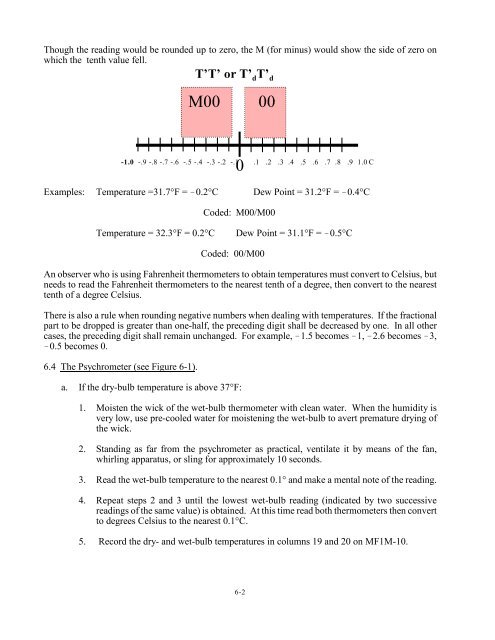Training Guide in Surface Weather Observations - Multiple Choices
Training Guide in Surface Weather Observations - Multiple Choices
Training Guide in Surface Weather Observations - Multiple Choices
You also want an ePaper? Increase the reach of your titles
YUMPU automatically turns print PDFs into web optimized ePapers that Google loves.
Though the read<strong>in</strong>g would be rounded up to zero, the M (for m<strong>in</strong>us) would show the side of zero on<br />
which the tenth value fell.<br />
-1.0 -.9 -.8 -.7 -.6 -.5 -.4 -.3 -.2 -.1 .1 .2 .3 .4 .5 .6 .7 .8 .9 1.0 C<br />
Examples: Temperature =31.7°F = 0.2°C Dew Po<strong>in</strong>t = 31.2°F = 0.4°C<br />
Coded: M00/M00<br />
Temperature = 32.3°F = 0.2°C Dew Po<strong>in</strong>t = 31.1°F = 0.5°C<br />
Coded: 00/M00<br />
An observer who is us<strong>in</strong>g Fahrenheit thermometers to obta<strong>in</strong> temperatures must convert to Celsius, but<br />
needs to read the Fahrenheit thermometers to the nearest tenth of a degree, then convert to the nearest<br />
tenth of a degree Celsius.<br />
There is also a rule when round<strong>in</strong>g negative numbers when deal<strong>in</strong>g with temperatures. If the fractional<br />
part to be dropped is greater than one-half, the preced<strong>in</strong>g digit shall be decreased by one. In all other<br />
cases, the preced<strong>in</strong>g digit shall rema<strong>in</strong> unchanged. For example, 1.5 becomes 1, 2.6 becomes 3,<br />
0.5 becomes 0.<br />
6.4 The Psychrometer (see Figure 6-1).<br />
a. If the dry-bulb temperature is above 37°F:<br />
1. Moisten the wick of the wet-bulb thermometer with clean water. When the humidity is<br />
very low, use pre-cooled water for moisten<strong>in</strong>g the wet-bulb to avert premature dry<strong>in</strong>g of<br />
the wick.<br />
2. Stand<strong>in</strong>g as far from the psychrometer as practical, ventilate it by means of the fan,<br />
whirl<strong>in</strong>g apparatus, or sl<strong>in</strong>g for approximately 10 seconds.<br />
3. Read the wet-bulb temperature to the nearest 0.1° and make a mental note of the read<strong>in</strong>g.<br />
4. Repeat steps 2 and 3 until the lowest wet-bulb read<strong>in</strong>g (<strong>in</strong>dicated by two successive<br />
read<strong>in</strong>gs of the same value) is obta<strong>in</strong>ed. At this time read both thermometers then convert<br />
to degrees Celsius to the nearest 0.1°C.<br />
5. Record the dry- and wet-bulb temperatures <strong>in</strong> columns 19 and 20 on MF1M-10.<br />
6-2

















